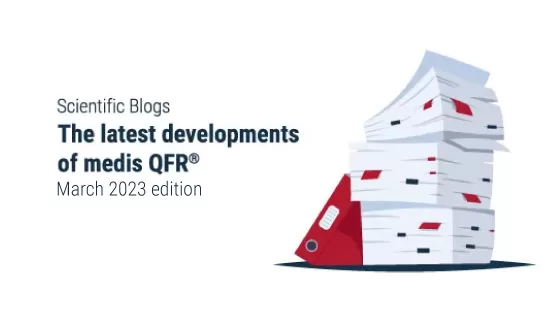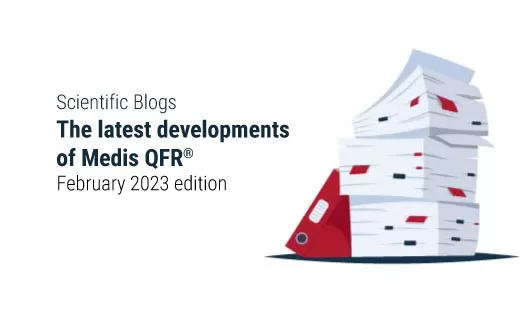Scientific Blogs
The latest developments of Medis QFR®
June 2023 edition
7 mins – June 14, 2023 – Written by Prof. Hans Reiber
We are delighted to present to you our latest Medis QFR® blog. By keeping you informed about the advancements and benefits of Medis QFR® in this rapidly evolving field, we strive to support your decision-making process and contribute to improved patient outcomes. Whether it’s the evaluation of lesion significance, personalized treatment decisions, or reducing adverse events, we aim to cover a broad range of topics related to Medis QFR® ‘s application and efficacy. This innovative and angio-based solution for coronary physiology has gained significant recognition and is extensively utilized in clinical research and practice globally. Discover five key publications that highlight the latest developments in Medis QFR® and join us in revolutionizing coronary physiology assessment. Keep informed, enhance patient care.
In this new Medis QFR® blog, we are proud to share five publications on the latest developments of Medis QFR with you.

Impact of quantitative flow ratio on graft function in patients undergoing coronary artery bypass grafting.
Dr. K. Sugimoto and co-authors under the supervision of Dr. G. Nakazawa from the Dept of Cardiology, Kindai University Faculty of Medicine in Osaka, Japan published this very interesting paper in Cardiovascular Interventions and Therapeutics. This PRIDE-METAL registry was a prospective, multicenter observational study that enrolled 54 patients with multivessel CAD. By protocol, left coronary stenoses were revascularized by CAG, and right coronary stenoses with stenting. QFR was performed at index angiography. Primary endpoint of this substudy was the discriminative ability of QFR for arterial graft function after 1 year FU. The diagnostic performance of QFR was substantial (AuC= 0.89) with an optimal cutoff of 0.76 to predict functionality of bypass grafts.
For further read: click here
In this new Medis QFR® blog, we are proud to share five publications on the latest developments of Medis QFR with you.

Coronary artery stenosis evaluation by angiography-derived FFR. Validation by positron emission tomography and invasive thermodilution.
J. Westra and co-authors under the supervision of Dr. E.H. Christiansen from Aarhus University Hospital in Denmark published this interesting study in JACC Imaging. This is a prospective study in 250 patients and 320 vessels on the evaluation of QFR and FFR with 82 Rubidium PET myocardial perfusion imaging as the reference standard. The authors found that QFR and FFR had similar diagnostic performance on a per-patient level accuracy (73% vs 71%), as per vessel accuracy (70% vs 68%). They concluded that the angio-derived FFR (=QFR) is able to identify prior evidence of ischemia to the same degree as invasive FFR.
For further read: click here

Angiography-derived FFR as novel parameter in assessing flow-limiting CAD?
Dr. T.H. Schindler and Dr. W.F. Fearon wrote an Editorial Comment in JACC Imaging on the paper by Westra et al. regarding the relationships between QFR and FFR versus PET perfusion imaging. They conclude that Westra et al provide further evidence of the value and validity of QFR, similar to invasively assessed FFR, in the identification of hemodynamically obstructive CAD lesions. Also, the promising role of QFR in the assessment of obstructive CAD in the catheterization laboratory and its clinical utility, however, need further validation in large-scale clinical investigations.
For further read: click here
Interested in the developments of Medis QFR ®?
Easily request a demo of our innovative software solution
Request a demo
Quantitative Flow Ratio for assessment of non-culprit coronary artery lesions during percutaneous coronary intervention (PCI) in 79 patients diagnosed with ST-elevation myocardial infarction (STEMI): A study from a single center in Lithuania.
Dr. M. Barauskas and co-authors from the Dept of Cardiology, Lithuanian University of Health Sciences in Kaunas, Lituania published this very interesting paper in Medical Science Monitor. This is a prospective single center study including 105 vessels from 79 STEMI patients. QFR analyses were performed during the index procedure (QFR1) and during a staged procedure ≥ 3 months later (QFR2). An excellent numerical agreement was found in all investigated lesions (r=0.931), as well as for the 3 main vessels separately. Clinical treatment decision-making showed amazing agreement between 1st and 2nd analyses (r=0.980). The authors concluded that the QFR is a practical quantitative method to evaluate non-IRA lesions.
For further read: click here

Applied coronary physiology for planning and guidance of percutaneous coronary interventions. A clinical consensus statement from the European Association of Percutaneous Cardiovascular Interventions (EAPCI) of the European Society of Cardiology.
Dr. J. Escaned from Hospital Clinico San Carlos in Madrid, Spain and many very well-known co-authors have written this Clinical Consensus Statement on behalf of the European Association of Percutaneous Cardiovascular Interventions (EAPCI) of the European Society of Cardiology. This is an excellent and extensive up-to-date overview of the evidences and expert opinions on the use of applied coronary physiology for PCI-planning, disease pattern recognition and post-PCI optimisation. This is a must-read for everyone active and interested in the field of coronary physiology.
For further read: click here
Share this article on:
Related articles

The latest developments of Medis QFR®
March 2023 edition

The latest developments of Medis QFR®
February 2023 edition

The latest developments of Medis Suite MR and CT
December 2023 edition

The latest developments of Medis QFR®
January 2023 edition
